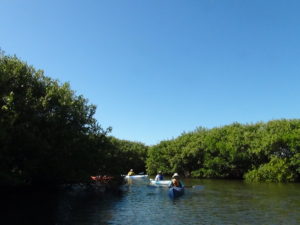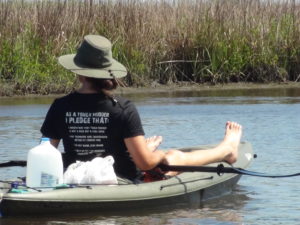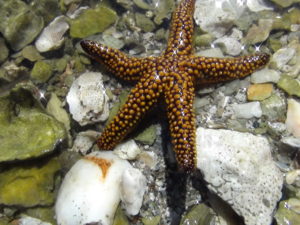Suncoast Keys Kayak Tour
Group size: 1 – 24
Trip time: 3-3.5 hours
Skill level: Beginner – pro. The open waters can be challenging
when the wind kicks up. Otherwise, it’s a breeze )
Cost
Most guided tours are $50 per person. (includes boat, paddle, vest, shuttling and your guide)
Using your Own Boat – $40. (many paddlers with their own boats like to join us to learn more about the history, archaeology and natural history of these rivers).
Dates
Join a scheduled tour (see tour calendar ), or suggest one. Find a free date on the calendar and suggest the trip of your choice. If there are no conflicts, we’ll post it!
OR
Schedule a private tour. Use contact form, email us at riverguide2000@yahoo.com or call (386-454-0611)
Location
Check the River Locator Map or Click the link below for a local map and then use zoom and panning arrows to explore the area. (Note: the marker is NOT our meeting place, but a nearby landmark.
Local Map

Coastal forest in Suncoast Keys
Description
This tour entails 4 – 4.5 hours of leisurely paddling on open coastal waters and skirting past several widely-scattered islands. Most are mangrove isles, but a couple are higher knolls situated atop ancient Indian shell middens with very interesting plant life. We’ll be stopping at a couple of these to look around. Of all the tours we offer, this offers the best chance to explore the interesting mangrove habitat.
The Suncoast Keys, located in the relatively quiet stretch of the Gulf coast, between Crystal River and Chassahowitzka, is one of those rare places in Florida where nature still holds sway. The dominant feature here are the islands – thousands of islands – ranging in size from small, green domes that could pass for a Galapagos tortoise on steroids (which would explain his unlikely presence here), up to serious miles-wide islands. It’s an area where quiet exploration is possible any day of the year.
The inner islands tend to be a bit higher, with a diverse canopy of cedars, pines, oaks and other hardwoods. If you’ve been on the Homosassa trip (the summer, version) you’ve experienced this part of the Suncoast keys. The outer islands, where we’ll be exploring this weekend, is the land of mangroves

There are actually four, unrelated species of mangroves, that are commonly grouped together (in life as well as in text) because of their shared affinity for the harsh saltwater environment. Each has evolved it’s own unique and interesting way of coping with the rigors of living here and each has different levels of tolerance. The leader of this hardy ensemble is red mangrove, whose ability to create land where it didn’t exist before, makes it one of the most important species along any coast that it is found.
Wherever conditions prevail (calm, shallow waters and warm temps) red mangroves, will set down roots – literally. The long, wax-covered seedlings (propagules) that develop on the tree before dropping, float the seas until finding a suitably shallow spot to anchor itself. The tree that follows is propped up out of the water on an elegant scaffolding of arching roots. These, in turn, catch other floating propagules and a mangrove forest is born. As sand builds up around the tangle of roots, the ground gets even shallower, creating the conditions favored by the next colonist to the community – black mangrove. The process continues with white mangrove and then buttonwood, which is adapted to the highest ground in the mangrove forest that is usually above water level.

But, enough mangrove science (I’ll tell you more when we get there). For many, it’s the remote tranquility and subtle beauty of these isles that are their greatest lure. Even from a distance, their dark green silhouettes, framed by expansive sheets of calm, shining water and a brilliant blue-white sky, excite the curious kid in all of us.
As you draw near, the first thing you notice is a dappling of bright yellow-orange. At first you think you think you’ve found a island of citrus, with plump orange fruit ripe for picking. Getting closer, you realize these are leaves that have turned color – one of the many interesting adaptations that you’ll find in the mangrove community for shedding salt.
Entering the world of the mangrove forest, odd shapes and features surround you on all sides; arching prop roots, pencil-like pneumatophores sticking up from the muck, tiny shadows scurrying in all directions. Oddest of all are the red mangrove propagules. At this season, they are well developed and are dangling awkwardly from the small flowery

base of their birth – like a kid who has outgrown the crib but refuses to leave. As they get longer, the propagule, with its little four-pointed flower bract on top, looks increasingly odd – sort of like a tall, lanky guitar player in a mariachi band. You know the one – tall and skinny, wearing a too-small sombrero atop his too-long head. He’s usually playing the smallest guitar.
On our trip, we’ll pass a couple of small, higher islands where we can stretch, snack and check out some of the island flora. One of our island stops (atop an Indian mound) has a better crop of my absolute favorite wild edible plant than any place I lead tours. That plant is ….. well, I guess I should leave something new to tell you about. 🙂
Difficulty
As on all our tours, we keep an easy pace as we skim the waters of the Suncoast Keys and around the scattered islands. Even so, the length of the tour (about 8 miles in 3.5 – 4 hours) can be tiring. This open environment can also be challenging on windy days. If it’s uncomfortably breezy we won’t go out.

 There are actually four, unrelated species of mangroves, that are commonly grouped together (in life as well as in text) because of their shared affinity for the harsh saltwater environment. Each has evolved it’s own unique and interesting way of coping with the rigors of living here and each has different levels of tolerance. The leader of this hardy ensemble is red mangrove, whose ability to create land where it didn’t exist before, makes it one of the most important species along any coast that it is found.
There are actually four, unrelated species of mangroves, that are commonly grouped together (in life as well as in text) because of their shared affinity for the harsh saltwater environment. Each has evolved it’s own unique and interesting way of coping with the rigors of living here and each has different levels of tolerance. The leader of this hardy ensemble is red mangrove, whose ability to create land where it didn’t exist before, makes it one of the most important species along any coast that it is found.  But, enough mangrove science (I’ll tell you more when we get there). For many, it’s the remote tranquility and subtle beauty of these isles that are their greatest lure. Even from a distance, their dark green silhouettes, framed by expansive sheets of calm, shining water and a brilliant blue-white sky, excite the curious kid in all of us.
But, enough mangrove science (I’ll tell you more when we get there). For many, it’s the remote tranquility and subtle beauty of these isles that are their greatest lure. Even from a distance, their dark green silhouettes, framed by expansive sheets of calm, shining water and a brilliant blue-white sky, excite the curious kid in all of us. 



